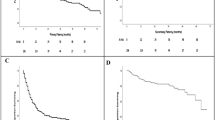Abstract
An arteriovenous fistula (AVF) between the radial artery and cephalic vein at the wrist is the preferred type of hemodialysis vascular access. However, in the practice of access placement, we are aware that some patients fail to form the standard forearm radial–cephalic AVF, owing to naturally small veins or acquired abnormal lesions of the veins. To identify the risk factors for failure to form the standard AVF, we examined 305 consecutive patients who underwent first-time access surgery at our hospital from January 2006 to December 2010. We compared the patients’ characteristics between those having normal vessels and successfully forming the standard AVF, and those having apparently abnormal vessels and thus forming alternative types of access instead. Histories of major and minor surgery were specifically evaluated, assuming that surgical procedures in the past could potentially damage the superficial veins. We created 207 standard and 98 alternative accesses during the period and found that significantly more patients with alternative accesses (31 %) had undergone major surgery of a variety of specialties, in comparison with those with the standard AVF (15.0 %). Multivariate logistic analysis revealed that a history of major surgery (OR = 2.39, 95 %CI 1.29–4.47, p = 0.006) and female gender (OR = 1.87, 95 %CI 1.10–3.20, p = 0.02) were independent risk factors associated with failure to construct the standard AVF. Our results indicate that previous surgery can damage the superficial veins and cause venous abnormality, which makes construction of the standard AVF difficult. We propose that care should be taken to preserve the superficial veins when patients for whom dialysis therapy is a future possibility undergo surgical procedures, especially invasive ones.


Similar content being viewed by others
References
NKF-K/DOQI Clinical Practice Guidelines for Vascular Access: Update 2006. Guideline 2: selection and placement of hemodialysis access, 2.1 the order of preference for placement of fistulae. 2006.
Sidawy AN, Spergel LM, Besarab A, Allon M, Jennings WC, Padberg FT Jr, et al. The society for vascular surgery: clinical practice guidelines for the surgical placement and maintenance of arteriovenous hemodialysis access. J Vasc Surg. 2008;48:2S–25S.
Ohira S, Naito H, Amano I, Azuma N, Ikeda K, Kikuta K, et al. 2005 Japanese society for dialysis therapy guidelines for vascular access construction and repair for chronic hemodialysis. Ther Apher Dial. 2006;10(5):449–62.
Monreal M, Oller B, Rodriguez N, Vega J, Torres T, Valero P, et al. Infusion phlebitis in post-operative patients: when and why. Haemostasis. 1999;29:247–54.
Uslusoy E, Mete S. Predisposing factors to phlebitis in patients with peripheral intravenous catheters: a descriptive study. J Am Acad Nurse Pract. 2008;20:172–80.
Nassaji-Zavareh M, Ghorbani R. Peripheral intravenous catheter-related phlebitis and related risk factors. Singapore Med J. 2007;48:733–6.
Sidawy AN, Gray R, Besarab A, Henry M, Ascher E, Silva M Jr, et al. Recommended standards for reports dealing with arteriovenous hemodialysis accesses. J Vasc Surg. 2002;35:603–10.
Feldman HI, Kobrin S, Wasserstein A. Hemodialysis vascular access morbidity. J Am Soc Nephrol. 1996;7:523–35.
Feldman HI, Held PJ, Hutchinson JT, Stoiber E, Hartigan MF, Berlin JA. Hemodialysis vascular access morbidity in the United States. Kidney Int. 1993;43:1091–6.
Astor BC, Eustace JA, Powe NR, Klag MJ, Fink NE, Coresh J. Type of vascular access and survival among incident hemodialysis patients: the choices for healthy outcomes in caring for ESRD (CHOICE) Study. J Am Soc Nephrol. 2005;16:1449–55.
Allon M, Robbin ML. Increasing arteriovenous fistulas in hemodialysis patients: problems and solutions. Kidney Int. 2002;62:1109–24.
Dhingra RK, Young EW, Hulbert-Shearon TE, Leavey SF, Port FK. The type of vascular access and mortality in U.S. hemodialysis patients. Kidney Int. 2001;60:1443–51.
Manns B, Tonelli M, Yilmaz S, Lee H, Laupland K, Klarenbach S, et al. Establishment and maintenance of vascular access in incident hemodialysis patients: a prospective cost analysis. J Am Soc Nephrol. 2005;16:201–9.
Lazarides MK, Georgiadis GS, Antoniou GA, Staramos DN. A meta-analysis of dialysis access outcome in elderly patients. J Vasc Surg. 2007;45:420–6.
Miller CD, Robbin ML, Allon M. Gender differences in outcomes of arteriovenous fistulas in hemodialysis patients. Kidney Int. 2003;63:346–52.
Huber TS, Ozaki CK, Flynn TC, Lee WA, Berceli SA, Hirneise CM, et al. Prospective validation of an algorithm to maximize native arteriovenous fistulae for chronic hemodialysis access. J Vasc Surg. 2002;36:452–9.
Allon M, Lockhart ME, Lilly RZ, Gallichio MH, Young CJ, Barker J, et al. Effect of preoperative sonographic mapping on vascular access outcomes in hemodialysis patients. Kidney Int. 2001;60:2013–20.
Wang W, Murphy B, Yilmaz S, Tonelli M, MacRae J, Manns BJ. Comorbidities do not influence primary fistula success in incident hemodialysis patients: a prospective study. Clin J Am Soc Nephrol. 2008;3:78–84.
Young EW, Dykstra DM, Goodkin DA, Mapes DL, Wolfe RA, Held PJ. Hemodialysis vascular access preferences and outcomes in the dialysis outcomes and practice patterns study (DOPPS). Kidney Int. 2002;61:2266–71.
Hodges TC, Fillinger MF, Zwolak RM, Walsh DB, Bech F, Cronenwell JL. Longitudinal comparison of dialysis access methods: risk factors for failure. J Vasc Surg. 1997;26:1009–19.
Coburn MC, Carney WI Jr. Comparison of basilic vein and polytetrafluoroethylene for brachial arteriovenous fistula. J Vasc Surg. 1994;20:896–902.
van der Linden J, Lameris TW, van den Meiracker AH, de Smet AA, Blankestijin PJ, van den Dorpel MA. Forearm venous distensibility predicts successful arteriovenous fistula. Am J Kidney Dis. 2006;47:1013–9.
Author information
Authors and Affiliations
Corresponding authors
Rights and permissions
About this article
Cite this article
Sato, Y., Miyamoto, M., Sueki, S. et al. Risk factors associated with inadequate veins for placement of arteriovenous fistulas for hemodialysis. J Artif Organs 16, 469–474 (2013). https://doi.org/10.1007/s10047-013-0729-x
Received:
Accepted:
Published:
Issue Date:
DOI: https://doi.org/10.1007/s10047-013-0729-x




